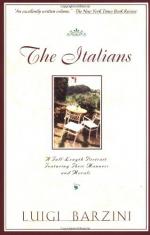The three portals are now open. From the lofty atrium raised on broad marble steps, with painted ceiling and sculptured walls—at one end a bubbling fountain falling into a marble basin, at the other an arched gate-way leading into grass-grown cloisters—the vast nave is visible from end to end. This nave is absolutely empty. Every thing tells of expectation, of anticipation. The mighty Lombard pillars on either side—supporting a triforium gallery of circular arches and slender pillars of marble fretwork, delicate as lace—are wreathed and twined with red taffetas bound with golden bands. The gallery of the triforium itself is draped with arras and rich draperies. Each dainty column is decked with flags and pennons. The aisles and transepts blaze with gorgeous hangings. Overhead saints, prophets, and martyrs, standing immovable in the tinted glories of the stained windows, fling broad patches of purple, emerald, and yellow, upon the intaglio pavement.
Along the nave (a hedge, as it were, on either side) are hung curtains of cloth of gold.
The high altar, inclosed by a balustrade of colored marble raised on steps richly carpeted, glitters with gemmed chalices and crosses. Behind, countless wax-lights illuminate the rich frescoes of the tribune. The Chapel of the Holy Countenance (midway up the nave), inclosed by a gilded net-work, is a dazzling mountain of light flung from a thousand golden sconces. A black figure as large as life rests upon the altar. It is stretched upon a cross. The eyes are white and glassy; the thorn-crowned head leans on one side. The body is enveloped in a damascened robe spangled with jewels. This robe descends to the feet, which are cased in shoes of solid gold. The right foot rests on a sacramental cup glittering with gems. On either side are angels, with arms extended. One holds a massive sceptre, the other the silver keys of the city of Lucca.
All waits. The bride, glorious in her garment of needle-work, waits. The bridegroom waits. The sacramental banquet is spread; the guests are bidden. All waits the moment when the multitude, already buzzing without at the western entrance, shall spread themselves over the mosaic floor, and throng each chapel, altar, gallery, and transept—when anthems of praise shall peal from the double doors of the painted organ, and holy rites give a mystic language to the sacred symbols around.
Meanwhile the procession flashes from street to street. Banners flutter in the hot mid-day air, tall crucifixes and golden crosses reach to the upper stories. In the pauses the low hum of the chanted canticles is caught up here and there along the line—now the monks—then the canons with a nasal twang—then the laity.




